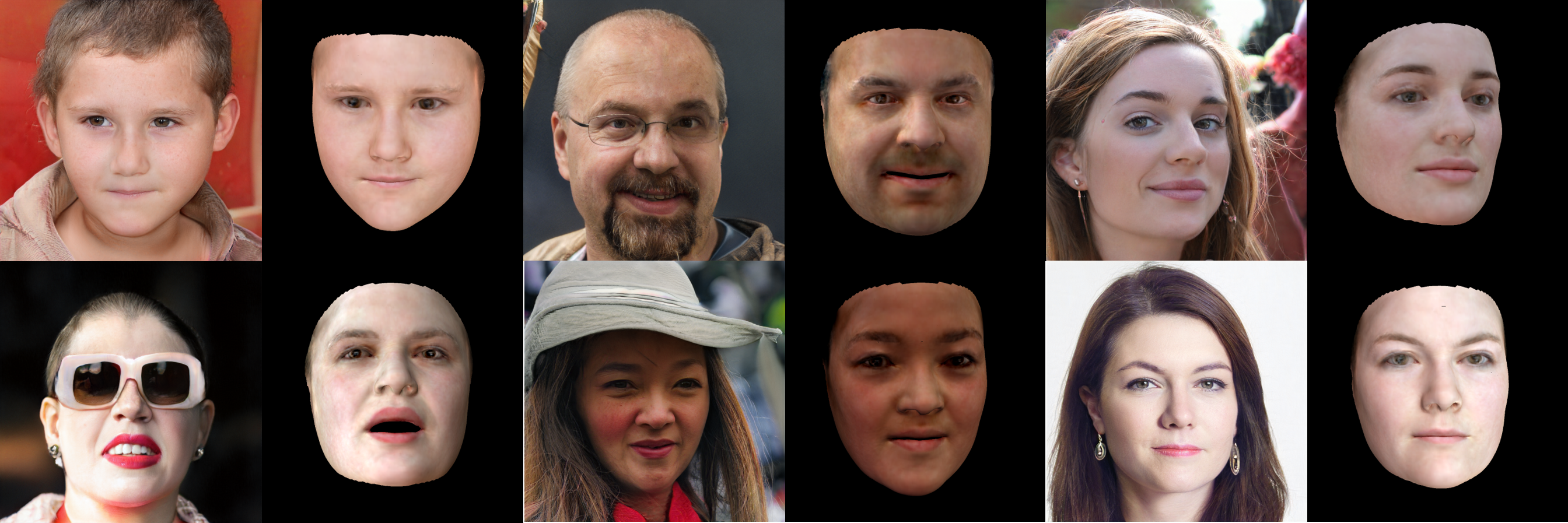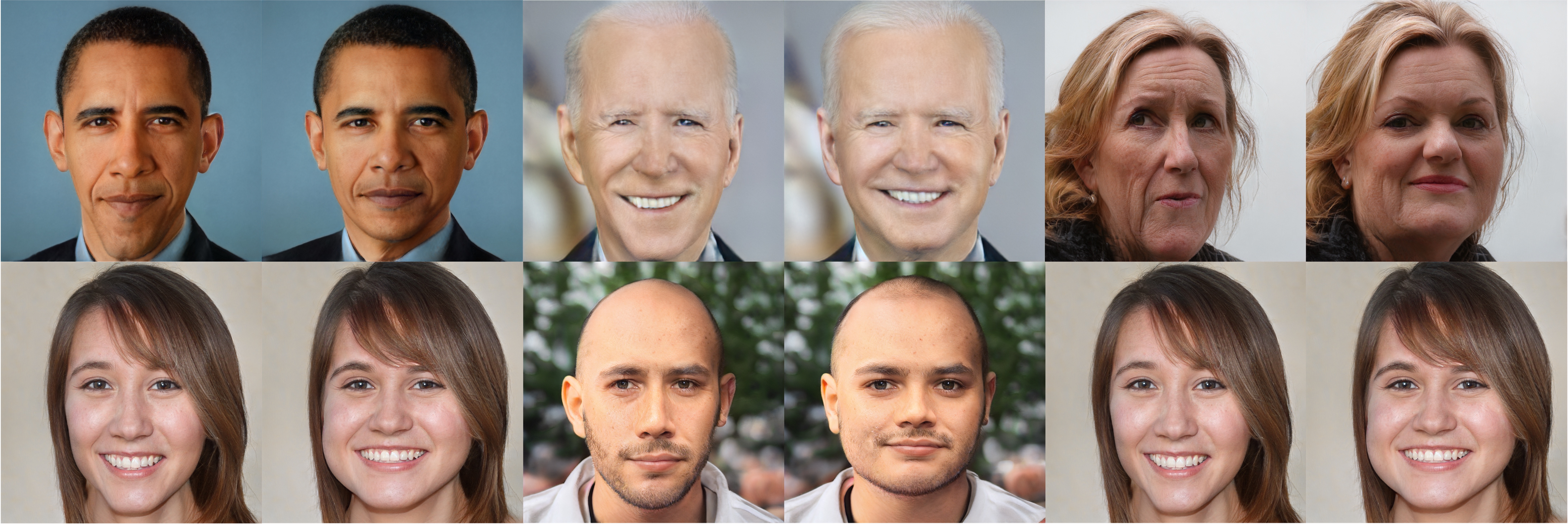Can Wang1,
Menglei Chai2,
Mingming He3,
Dongdong Chen4,
Jing Liao1
1City University of Hong Kong, 2Creative Vision, Snap Inc., 3USC Institute for Creative Technologies, 4Microsoft Cloud AI
- Python 3.8
- Torch 1.7.1 or Torch 1.8.0
- Pytorch3D for rendering images
Note: Related checkpoints and 3DMM bases can be downloaded from here; you can also take the following steps to prepare these.
- Download the StyleGAN2 checkpoint from here and place it into the 'stylegan2-pytorch/checkpoint' directory.
- For quickly trying our method, I recommend to generate 4K latent(StyleSpace)&image training pairs:
cd stylegan2
python generate_data.py --pics 4000 --ckpt checkpoint/stylegan2-ffhq-config-f.pt
Once finished, you will acquire 'Images', 'latents.pkl', and 'constants.pkl' files.
- Download checkpoint from here and place it into the 'Deep3DFaceReconstruction-pytorch/network' directory;
- Download 3DMM bases from here and place these files into the 'Deep3DFaceReconstruction-pytorch/BFM' directory;
- Estimate 3DMM parameters and facial Landmarks:
cd Deep3DFaceReconstruction
python extract_gt.py ../stylegan2/Images
Once finished, you will acquire the 'params.pkl' file. Then estimate the landmarks using dlib and split training and testing datasets. Please download the dlib landmark predictor from here and place it into the 'sample_dataset' directory.
mv stylegan2/Images sample_dataset/
mv stylegan2/latents.pkl sample_dataset/
mv stylegan2/constants.pkl sample_dataset/
mv Deep3DFaceReconstruction-pytorch/params.pkl sample_dataset/
cd sample_dataset/
python extract_landmarks.py
python split_train_test.py
Copy BFM from Deep3DFaceReconstruction:
cp -r Deep3DFaceReconstruction-pytorch/BFM/ ./bfm/
Then train the Attribute Prediction Network:
python train.py --name apnet_wpdc --model APModel --train_wpdc
Test the Attribute Prediction Network and you will find results (the rendered image and the mesh) in the 'results' directory:
python evaluate.py --name apnet_wpdc --model APModel
Some test results of APNet (Please use more synthesized data to improve performance and training robustness):
Some important parameters for training or testing:
| Parameter | Default | Description |
|---|---|---|
| --name | 'test' | name of the experiment |
| --model | 'APModel' | which model to be trained |
| --train_wpdc | False | whether use WPDC loss |
| --w_wpdc | 0.1 | weight of the WPDC loss |
| --data_dir | 'sample_dataset' | path to dataset |
| --total_epoch | 200 | total epochs for training |
| --save_interval | 20 | interval to save the model |
| --batch_size | 128 | batch size to train the model |
| --load_epoch | -1 (the final saved model) | which checkpoint to load for testing |
Train the Encoder and Decoder for the attribute editing in real face domain (e.g. shape editing):
python train.py --name shape --model RIGModelS --train_render --train_landmark --train_rec --train_edge --load_apnet_epoch 80
Test the editing process and you will find results (the rendered images, meshes, and editing results) in the 'results' directory:
python evaluate.py --name shape --model RIGModelS --load_apnet_epoch 80
Some test results of Shape editing (Please use more synthesized data to improve performance and training robustness):
Some important parameters for training or testing:
| Parameter | Default | Description |
|---|---|---|
| --train_render | False | whether use render loss |
| --train_landmark | False | whether use landmark loss |
| --train_rec | False | whether use recycle loss |
| --train_edge | False | whether use edge loss (only for shape editing) |
| --load_apnet_epoch | -1 | which APNet to load for training or testing |
| --model | 'RIGModelS' | RIGModelS, RIGModelE, RIGModelL, RIGModelP, RIGModelA for shape, expression, light, pose, and albedo editing |
Download the Disney girl dataset from here. Thanks Jing Bo for helping collect this dataset from Pinterest. Other datasets used in our paper can be obtained from the Internet, please refer to our paper.
Preprocess the dataset:
cd stylegan2/
python prepare_data.py --out LMDB_disney_1024 --n_worker 2 --size 1024 data_disney_girl
Finetuning StyleGAN2:
python finetune.py --ckpt checkpoint/stylegan2-ffhq-config-fine.pt --size 1024 --batch 16 --n_sample 2 LMDB_dog_1024/
I recommend to finetune using multi-gpus by adding 'CUDA_VISIBLE_DEVICES=0,1,2,3'. Try reducing the batch-size and n_sample to support a single gpu. Given a latent code corresponding to a non-real human face, you can edit it using the Editing Network trained in step 4, but produce results with the finetuned checkpoint. You can directly download the finetuned models from here. Thanks Jia Lu for discussing about the style transfer of StyleGAN.
ppython evaluate.py --name shape --model RIGModelS --load_apnet_epoch 80
-
Code for generating latent&image training pairs; -
Code for estimating 3DMM parameters and landmarks; -
Code and pre-trained models for the Attribute Prediction Network; -
Code and pre-trained models for the Latent Manipulation Network; -
Code, Data and pre-trained models for Latent-Consistent Finetuning; - A Google Colab to train and test the method.
- StyleGAN2-pytorch: https://github.com/rosinality/stylegan2-pytorch
- Deep3DFaceReconstruction-pytorch: https://github.com/changhongjian/Deep3DFaceReconstruction-pytorch
- FreezeG: https://github.com/bryandlee/FreezeG
If you find our work useful for your research, please consider citing the following papers :)
@article{wang2021cross,
title={Cross-Domain and Disentangled Face Manipulation with 3D Guidance},
author={Wang, Can and Chai, Menglei and He, Mingming and Chen, Dongdong and Liao, Jing},
journal={arXiv preprint arXiv:2104.11228},
year={2021}
}




